Attracting
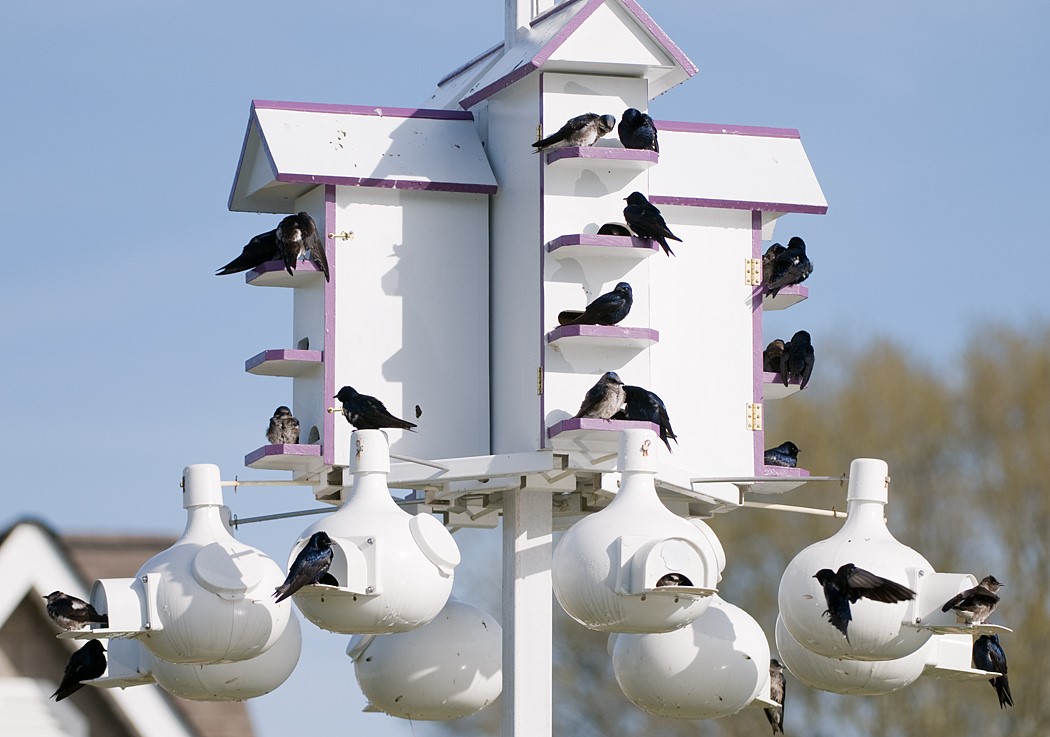
How do you get Purple Martins to come & stay at your location?
Offer Suitable Housing
Since purple martins like to live in colonies, it is best to offer housing with several compartments or single housing in a larger array. These come in wood, plastic, and aluminum. Modifications to these can be made to suit your location. You may wish to use a few round holes to start and then change over to suitable starling-resistant holes if they become problematic. Some types are found in the photo below. The critical key to excluding starlings is to maintain the 1 3/16″ hole height so the martin can enter.
John Miller from the PMCA Forum gives his tip on checking and correcting hole size.
” I advise always measuring starling resistant entrance holes (SREH) on new housing, especially plastic ones on plastic houses or gourds, or in older housing that has never been occupied.”
I sometimes find the openings are too small. I offer this tip with two serious precautions 1. Never over-open an SREH, as it will quickly lose its ability to restrict starlings. 2. Begin with making a measuring gauge, and confirm its accuracy. I make what I call a no-go gauge. It’s a piece of aluminum (could use plastic or even poster board for temporary use) cut into a tapered wedge on top and flat on the bottom. I carefully draw a line at 1 3/16 and another at 1 7/32. Insert into an entrance and it should stop at 1 3/16 for crescents, and no larger than, or in between the lines, for 1 3/16 and 1 7/32 for openings with pips, such as Excluder II. (the original Excluder is 1 3/16) To double-check that you have set the gauge correctly, (you can’t rely on a ruler to confirm if your eyes are of a certain age) one can use calipers, or you can insert it into a trusted opening, such as the one shown (cut by Sandy Bunn).
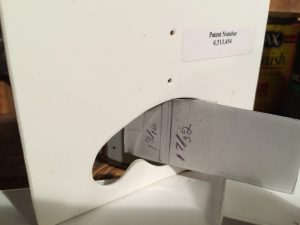
Usually, factory aluminum entries are correct, but there are variances in plastic in my spot-checking. If an opening is necessary, sand with fine grade sandpaper and finger/hand pressure; going slowly.
Use Starling Resistant Entrance Holes

Starling Resistant Entrance Hole History
The search for the best hole to exclude starlings from purple martin houses started several years ago when it was determined that this introduced species had created havoc among the martins by destroying not only their eggs and young but adult martins as well. It wasn’t a pretty scene as several colonies were literally overtaken by its brazen attacks.
Charlie McEwen had experimented with ways to keep the non-native, European Starling out of martin houses in the early 1980s. One of the reasons martins aren’t as abundant as they used to be, is because, in the 19th century, humans released a few starlings into this continent from Europe. In the decades that followed, starlings spread, unchecked, like the feathered black plague, at the expense of many native cavity nesters. Unfortunately, starlings aggressively took over martin houses, where they bludgeoned martins to death with their long, sharp beaks, punctured and ate their eggs, and through their territorial aggression, prevented martin colonization at unmanaged martin houses. Because martins didn’t coevolve with the severe depredations caused by these non-native pests, they didn’t lay enough eggs to compensate – therefore, martin populations declined severely from what they were a century ago.
As one of the founders and officers of the Purple Martin and Bird Society of Southeastern New Brunswick, Charlie had the membership test this innovative entrance design at the northern limit of the martin’s breeding range, throughout the province of New Brunswick. He also has tested the entrance design in several locations around Lantana, FL., near the southern limit of the martin’s breeding range. Guess what? They seemed to work! A similar starling-proof hole has been recommended by the U. S. Fish & Wildlife Service and used successfully in the Pacific Northwest (i.e., in Oregon and Washington). Their entrance hole was a rectangular slot measuring 2-3/4″ wide and 1-1/4″ high placed flush with the porch and compartment floor.
Over the years several landlords have experimented with martin house entrances, and some have modified the crescent hole to make it adjustable. Ron Seekampf of Findley, Minnesota created a plate so the hole could be adjusted to allow larger martins to learn the hole and then reduce the size of the hole to 1- 3/16”.
The Obround entrance came around in the ’90s and so came more experiments with starlings and entrances. Tom Dellinger did extensive studies on the oblong hole and discovered that the starling had more room for twists and turns. As a result, it was recommended that the hole not be used with porches.
Duke Snyder was a pioneer in developing the Snyder Excluder Hole. Duke Snyder did his homework and testing of his innovation over a three-year period at his very successful martin colony in Western Pennsylvania. His first templates of the original Excluder and the Modified excluder were retro-fitted to martin houses and gourds and very few starlings breached this hole. He was also one of the very first martin landlords to patent his invention. His patented gourds now include his SRE entrance holes.
Willie D. Conley, an Amish landlord experimented with Duke’s design and realized that if three 1-3/16” holes were drilled side by side, the martins would have more wiggling room and thus be able to enter this entrance. The Conley entrance is widely used today. Willie continues to experiment with other entrance holes and he has developed a new Conley entrance, supposedly starling proof.
Brian Naughton also experimented with a 1-3/16” hole times five and came up with the Naughton 5 Holer. I haven’t heard too much about this entrance type. It allows for many more young martins to feed at the entrance.
Several other developers came up with modifications to the crescent including Mike Brown. His Clinger was extensively tested and also great without porches but it too has not been starling proof.
A.C Moser developed another entrance which he and Bob Flam experimented with to refine the shape. It is an exclusive ACE design and is more restrictive than others. Starlings have a hard time getting in but purple martins have mastered it.
The Purple Martin Clubhouse members developed an entrance a way back that was a combination of an oblong and the 1-3/16” center round hole. It was called the Clubhouse entrance and was tested and used by its owners. There were others on the forum who developed entrances on the theory that theirs would work and they did at their colonies.
Ken Landry experimented with a brand new shape of hole or should I say holes which allow the purple martin to enter and for the young to feed. It consists of two entrances holes side by side. I have not heard too much about this entrance type and its relative success nor have I heard about any failures.
Most of these Starling Resistant Entrances have issues because no two martins are the same size and definitely no two starlings are the same size nor have the same determination.
Entrances come with their own baggage as well as their problems. What landlords must realize is that we live in a world where round holes don’t work with deeper compartments and starling numbers are growing exponentially. Their tenacity only makes the hobby more difficult and causes further problems for the landlord. Entrance holes cause the occasional wing entrapment so now we need some form of added wing entrapment guard on the SRE. The list of developments and precautions which have developed over these entrances can cause one to think twice about the martin hobby. Some choose to ignore the SRE and let nature take its course and eventually give up the hobby.
But one thing is for certain, as martin numbers decline, we will be forced to develop newer techniques to curtail the loss of purple martins in our areas.
The purple martin is still one songbird worth saving despite all the hassles its competitors continue to throw at it! Consider using at least one type of SRE at your colony, you will be glad you did.
How to Make a Starling Resistant Entrance Hole
Starling-resistant entrance holes have been around for a number of years now and most houses or gourds come equipped with one of these entrances already installed. Although many claims have been made that they are starling proof, this may not be the case since there are always exceptions to the rule. Martin landlords usually install a Starling Resistant Plate on the housing they use and it often excludes the ever-persistent European Starling, an introduced species which will take over housing, chase away martins, and even kill adults. These entrance holes are extremely helpful in deterring the Starling when the houses are not being monitored.
A 1- 3/16” Forstner bit is usually used to cut the required hole dimensions but there are many creative landlords who use routers, Dremel tools, etc. with patterns to cut out the required shape.
Starling-resistant entrances come in many shapes and sizes with or without patents. So be careful to create those that are non-patented for obvious reasons. The images provided by the Purple Martin Conservation Association are examples of entrances that are allowed to be created or purchased.
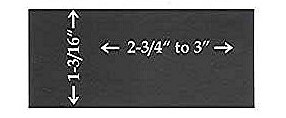
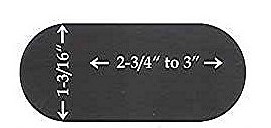

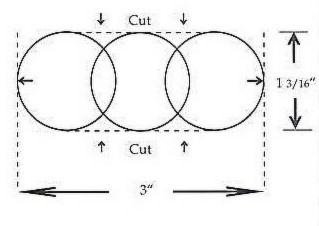
Placement of Housing
Housing should be placed at least 20 -40 feet away from trees, buildings, or other structures to avoid any problems with predator intrusion. If you have a water source nearby, this is a bonus as martins like to be near water. Housing located on bodies of water often fair better than land-based housing. Martins will often leave their housing to go to the water to drink and bathe and seek out insect life.
Purple Martin Songs/Decoys
Playing recorded Purple Martin songs particularly early in the morning or throughout the day can attract Martins to check out your housing, although it may not guarantee they will remain and nest. Having a purple martin decoy placed on your housing will often lure young first-year martins to your site. These are the purple martins that usually start new colonies. It is important to cease playing the tape if hawks are in the area as this will attract them to your site if it is played too often or too long during the day.
Keep the Competition Away
Today Starlings and House Sparrows are the most common problem invasive species around purple martin colonies and will often establish their presence at your housing before the martins take up residence. Closing up holes in the housing before martins arrive will discourage the invasive species but they will reappear when the martins arrive and cause further problems by fighting with the martins or by destroying their nest and eggs. The key is to alleviate the source of the problem. If you have a house with just round entrance holes, you may even wish to have some starling-resistant entrances installed on your housing to prevent the starlings from starting to nest. There are several website articles on dealing with these species and encouraging martins to stay.
Start a Nest
When you open up a couple of compartments for the martins, make it welcome for the visitors. Introduce some twigs, soybean straw, wheat straw, cedar chips, or pine needles on the floor of the housing to look like it’s been lived in. They should be cut into martin manageable pieces . Smear some mud at the front door and on the back walls to design that lived-in look and follow Del McKinnon’s suggestions below.
Purple Martin Lures and Attractants
Often potential landlords have followed the necessary steps to get housing ready but still do not get martins. Try the following suggestions and this may assist in getting that first pair. Martins love prebuilt nests, especially the young SY birds, they arrive later in the season, are rookies at nest building, and are also hard-pressed for time. So a pre-built nest is very inviting to them. You can greatly increase your chances of getting them to stay and nest at your site with a pre-built nest. Using the dense Styrofoam (blue or pink) as a sub-floor about 1/2″ to 1″ thick helps to keep the nestlings warm, and also supplies good traction for their feet avoiding leg splaying when they grow. The females often will scratch out their own nest bowl in it themselves. Place a 1/2″ to 1″ thick Styrofoam on the compartment floor (or nest tray floor behind the perch). Then paint the Styrofoam as well as all the sides of the compartment with mud. Then add a small handful of stubble straw, bean straw, or pine straw, cut into 3-inch lengths to the nesting area, it also doesn’t hurt to add a few green leaves to the nest. The nest is now ready and the martins will find it very hard to resist.
If you choose not to use Styrofoam, you can construct/purchase a nest insert for your house and prepare the bedding material similar to the Styrofoam tray. These nesting trays are readily available from supply houses for various house styles. Compress wheat, bean, or pine straw and add it to the tray to indicate last year’s nesting material. If the straw is difficult to work with, give it a spray of water and it will definitely be more manageable.
Del McKinnon from the Purple Martin Conservancy suggests artificial spotting inside the compartment. Using a small paintbrush or Q-tip – R Trademark and non-toxic craft paint, dab a series of spots similar to young martin droppings in a strip about 2- 4-1/2 inches up the wall and entrance to mimic the lived-in look. When the martin peeks in and sees the compartment, he will gladly move in because it looks previously used by baby martins. With mud and artificial fecal spotting, you have the real lived-in look.
A dawn song tape or CD player in the early morning hours in May and June will be a beacon for returning martins. Duck hunters have used artificial calls for years and the new apps available on phones and tablets are also ways of attracting them when you are close by. The Dawn Song or Chatter cd mimics adult martins in such a way that the recording of this song will attract any Martin that hears it.
Add a purple martin decoy to a perch, a rooftop, or a pole perch and you have the rest of the equation. Although this is not a guarantee of hosting martins, give it a try and you may be surprised at your success!

